Short Beaked Echidna Facts
The Short Beaked Echidna is like several animals rolled into one! It has sharp spines like a Porcupine, a long bird-like beak, and a pouch to hold its young like a Kangaroo! It is one of Australia’s most iconic animals. Fun fact: even though it is a mammal, the Short Beaked Echidna lays eggs like a reptile! Let’s find out more about this amazing animal.
Echidna Pronunciation
Some of you might be confused over the pronunciation of Echidna in the animal’s name. But it’s actually pretty easy! To say it correctly, we simply break the word down into three parts: Uh-Kid-Nuh. Go ahead and practice saying it aloud!
Short Beaked Echidna Appearance
Short Beaked Echidnas are medium-sized mammals. They are covered in coarse hair and needle-like spines averaging 2 inches in length. They weigh anywhere from 4 to 15 pounds. Some individuals can weigh up to 22 pounds!
They are typically 12 to 18 inches in length. They have a long and slender snout that works both as their nose and their mouth. The snout is generally 2.4 to 3 inches long. Their fur is typically dark in color, ranging from honey to dark reddish-brown to even black. Their spines are cream-colored.
What do Echidnas eat?
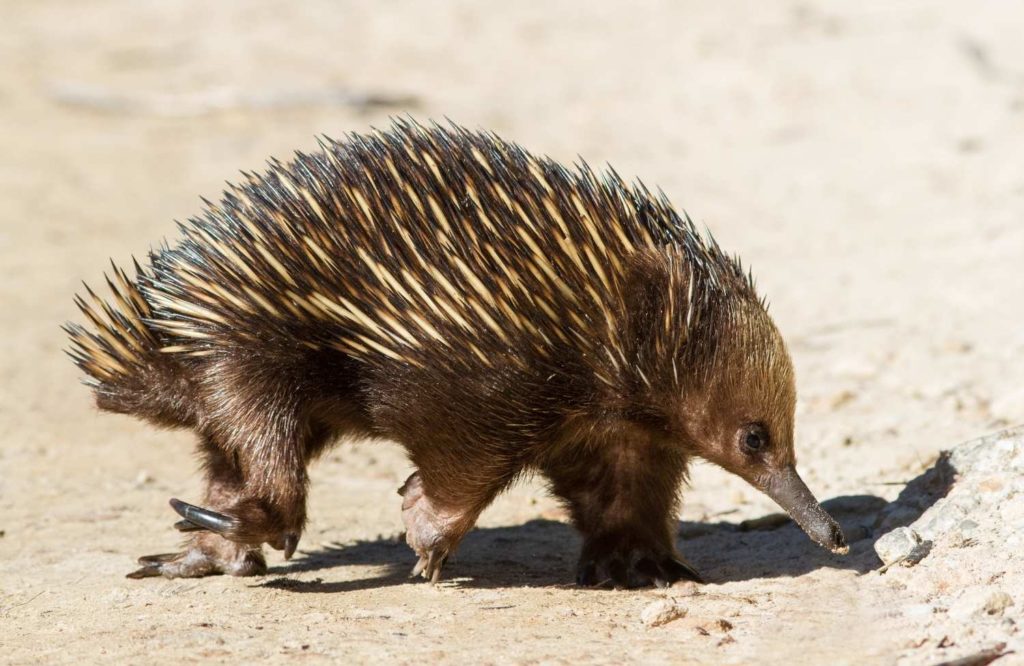
The Short Beaked Echidna has a diet primarily consisting of ants and termites. Because of this, they were traditionally known as ‘spiny anteaters.’ They prefer the eggs, pupae, and winged phases of these insects. They also hunt moths, beetles, and earthworms, depending on their location.
Short Beaked Echidnas are believed to locate food using their sense of smell. They use their strong claws to pull apart ant colonies and termite nests in rotting logs before feeding. They can also feed rather quickly, with a single 6.5 pound Echidna devouring over 7 ounces of termites in just 10 minutes!
The tongue of the Short Beaked Echidnas is their only way of catching prey. It can extend up to 7 inches outside the snout. The tongue is highly sticky due to the presence of mucus. This sticky tongue helps them catch insects. It can also stiffen up and penetrate wood or soil. Their tongue moves very quickly and can enter and exit the snout 100 times in a minute!
Where do Short Beaked Echidnas live?
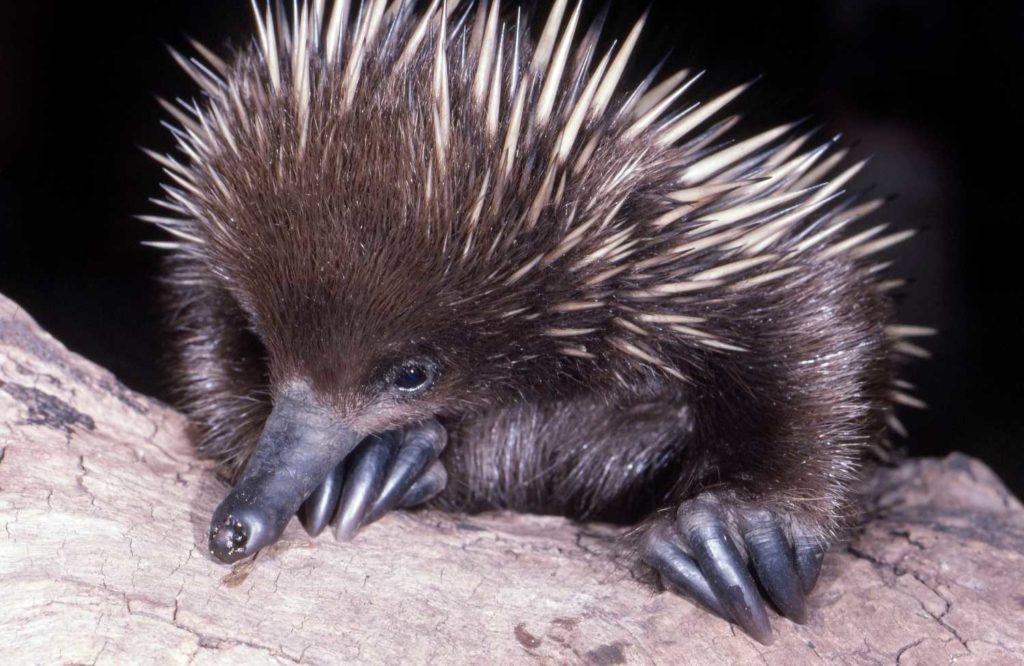
The Short Beaked Echidna can be found throughout Australia. It is actually the most common native mammal on the continent! It is mainly seen in Tasmania and Kangaroo Island. It is also seen in southwestern New Guinea. Here, the Echidna mostly resides in coastal or highland areas.
Short Beaked Echidna Habitat
Short Beaked Echidnas occur in a variety of terrestrial habitats. They are found everywhere, from snowy hills to tropical forests. Some Echidnas have even been found at altitudes of 5500 feet! They mainly thrive in savannas and woodlands, arid and agricultural regions.
In general, Short Beaked Echidnas avoid extreme temperatures. Instead, they use their strong limbs to make burrows in the soil. They also hide in hollow logs, rock crevices, and under vegetation. They are good swimmers too! They can sometimes be seen cooling off near dams, or crossing rivers by using their snouts as a snorkel!
Echidna Lifespan
Short Beaked Echidnas live incredibly long for their size! Their average lifespan is around 10 years in the wild. But individuals have been known to live up to 40 years! In captivity, the longest recorded lifespan for a Short Beaked Echidna was 50 years.
Their metabolism rate is the lowest of any mammal. They have a slow rate of reproduction. They also have a relatively low body temperature. Their temperature is usually about 91 degrees Fahrenheit, even when they’re not hibernating. This has the combined effect of increasing their lifespan.
Short Beaked Echidnas Behavior and Characteristics
‘Snuffling’ on a hunt
Short Beaked Echidnas have a highly evolved and keen sense of smell. They use it for both detecting mates and prey. To locate food, they use sensors on the tip of their snouts. They randomly shuffle around the ground, probing and smelling with their snouts. In the process, they make a characteristic breathing noise known as snuffling.
Defense Mechanisms
Generally, Short Beaked Echidnas try to avoid getting seen by predators. They use the color of their spines and fur to blend into the environment. They do this by camouflaging among the dry vegetation. They have good hearing too. Whenever they sense predators nearby, they stop in their tracks to avoid being noticed.
When in danger, Short Beaked Echidnas will hide beneath rocks and logs. If they cannot find cover, they will use their front paws to quickly dig themselves into the ground. Otherwise, they will roll themselves into a ball. This pose protects their belly and the soft underside. It leaves only the spiny outer part to fend off any threats.
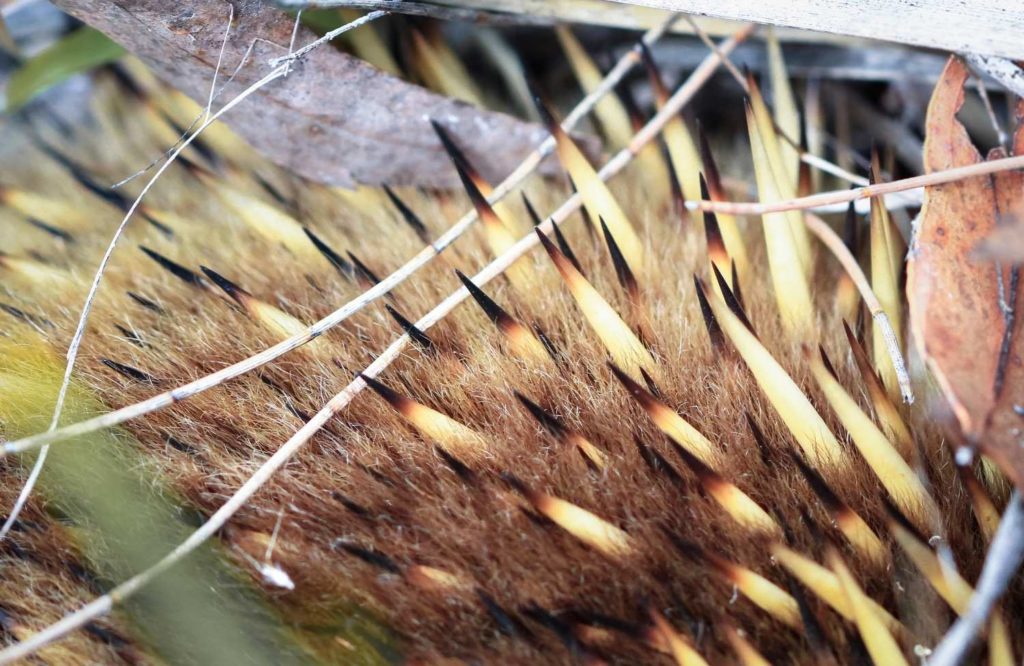
Short Beaked Echidnas may even pee to deter attackers! This is because their urine is pungent and foul-smelling. Male Echidnas also have a spur on their hind legs. It is believed that these spurs could secrete venomous substances at one time in history. However, they have long since lost the ability to do so.
Electroreceptors in the Beak
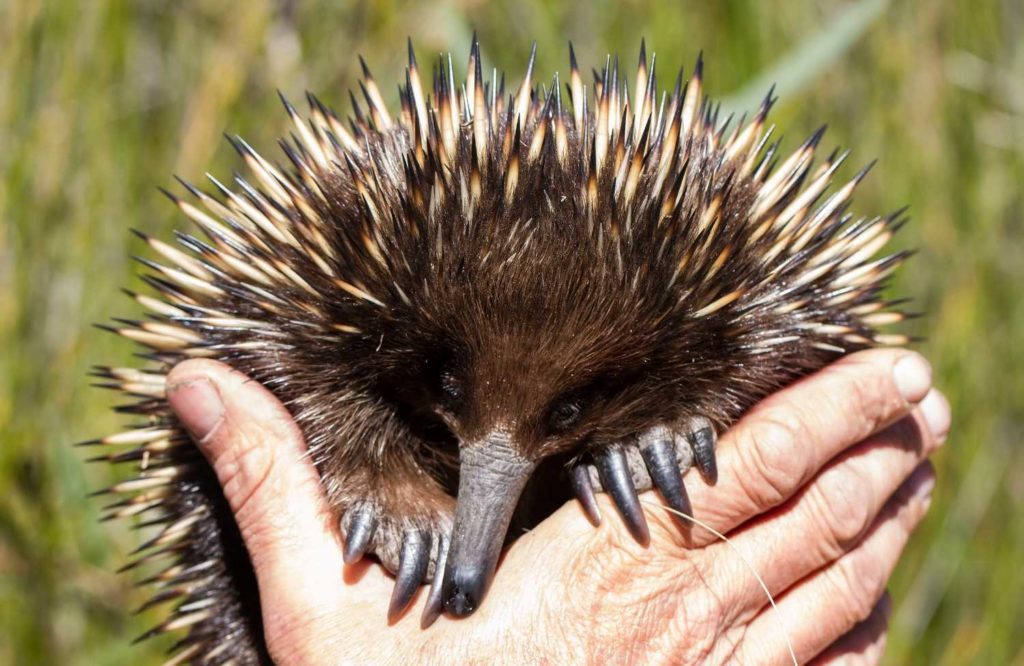
The beak of an Echidna has many receptors, or senses. These senses give them an idea about their surroundings. They have nerves coming out from tiny holes in their snout. These nerves help them figure out the temperature and pressure of the environment.
They also have special senses called Electroreceptors. They look like glands at the end of their snouts. They allow Echidnas to sense electric fields. There are about 400 electroreceptors in a Short Beaked Echidna’s snout. Scientists believe that this allows them to sense buried prey in their nests. The receptors are especially helpful after rain or in humid habitats.
Remarkable Strength
Short Beaked Echidnas show remarkable strength. They have very tough muscles. This is mainly seen around the shoulders and torso. Their limbs are short with strong claws. This lets them dig rapidly. They can also use their limbs to tear apart large logs and move rocks. Their arms can exert more power than even humans!
The Echidnas also have an enormous special muscle called panniculus carnosus. It sits just below their skin and covers almost their entire body. By contracting this muscle at specific places, an Echidna can change its shape. This is most obvious when they curl up into a ball defensively!
Their face, snout, and tongue are also extremely tough. The beak is shaped like a double wedge. This shape is very efficient for digging. The blood flow through the tongue can make it very firm and rigid while hunting. Echidnas can also use their snout and tongue to break large prey into smaller pieces!
Reproduction and Breeding in Echidnas
Short Beaked Echidnas reach maturity between five and twelve years of age. They are solitary mammals, which means they prefer living alone. This is why they have to actively search for mates between May and September. During this mating season, both males and females give off a musky smell to attract partners.
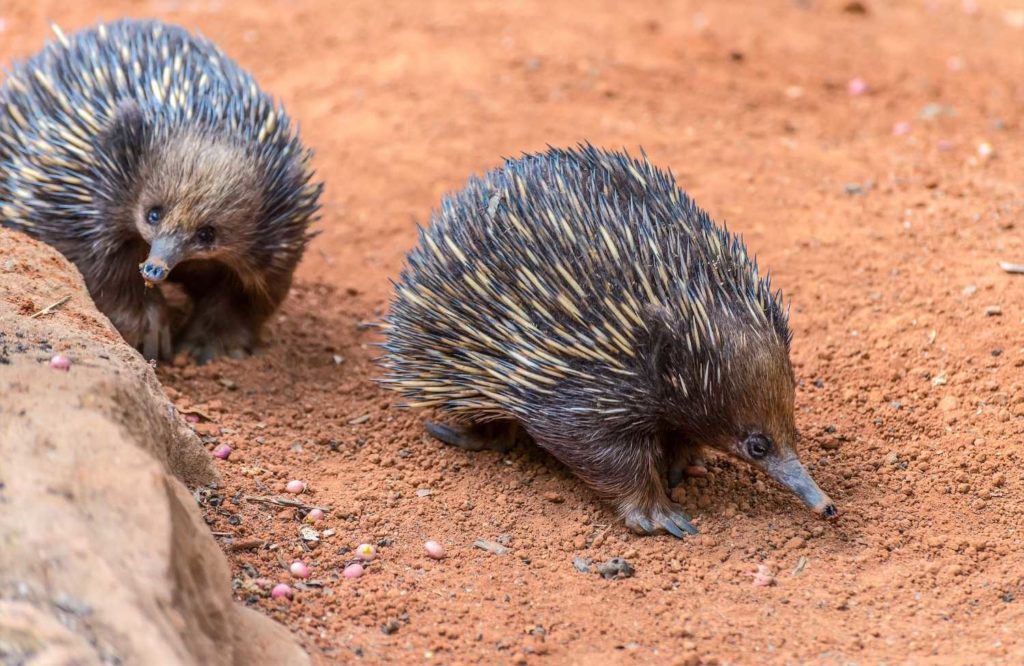
Males first locate and pursue female Echidnas. Sometimes, up to ten males may follow a single female in a mating ritual for over 4 weeks. This is called a train. These trains search for food together, and males keep entering and exiting the group. The males will fight among themselves to determine who gets to mate with the female.
The female may roll up into a ball to reject the male. If she accepts, the two lie together, abdomen to abdomen, in their mating position. The mating process can take up to 3 hours. The Short Beaked Echidna has only one opening called a cloaca. This acts as a passage for feces and urine, and the reproductive organ!
Echidna Eggs
Females mate only once in a breeding season, and each mating session leads to only a single egg being formed after 21 to 28 days. The female develops a pouch on her abdomen during this period, where the egg eventually gets laid.
Along with Platypuses, Echidnas are the only other group of mammals that lays eggs! The egg is small, soft, and cream-colored. It is about 0.6 inches in size and between 0.05 to 0.07 ounces in weight. It is oval in shape, and its skin is rubbery to the touch.
Baby Echidna
The egg hatches within the pouch after 10 days of being laid. Echidna hatchlings are only 0.6 inches long – as big as the egg – and weigh between 0.011 to 0.014 ounces. These baby Echidnas are also called puggles! What a cute name!
Echidna puggles already have well-defined front legs and claws when they are born. This allows them to climb out of the mother’s pouch. They then attach themselves to their mothers’ areolae. These are special patches on the skin that secrete milk. Puggles can drink large amounts of milk during each feeding period!
After two to three months, the young Echidnas are ejected from the pouch as their spines grow in length. The mothers leave them unattended in burrows while they go out in search of food. After about 180 days, the younglings leave the burrows to go live on their own and never return to the mother!
Short Beaked Echidna Scientific Name and Classification
Short Beaked Echidnas were discovered and named in 1792 by George Shaw, who thought they were related to anteaters! But later, their species name was revised. Their scientific name is now known as Tachyglossus aculeatus. Tachyglossus actually means ‘quick tongue,’ while aculeatus means ‘spiny’!
Short Beaked Echidnas belong to the family Tachyglossidae along with Long Beaked Echidnas. Along with Platypuses, the Echidnas belong to the order Monotremata or Monotremes. This is the only group of egg-laying mammals in the world!
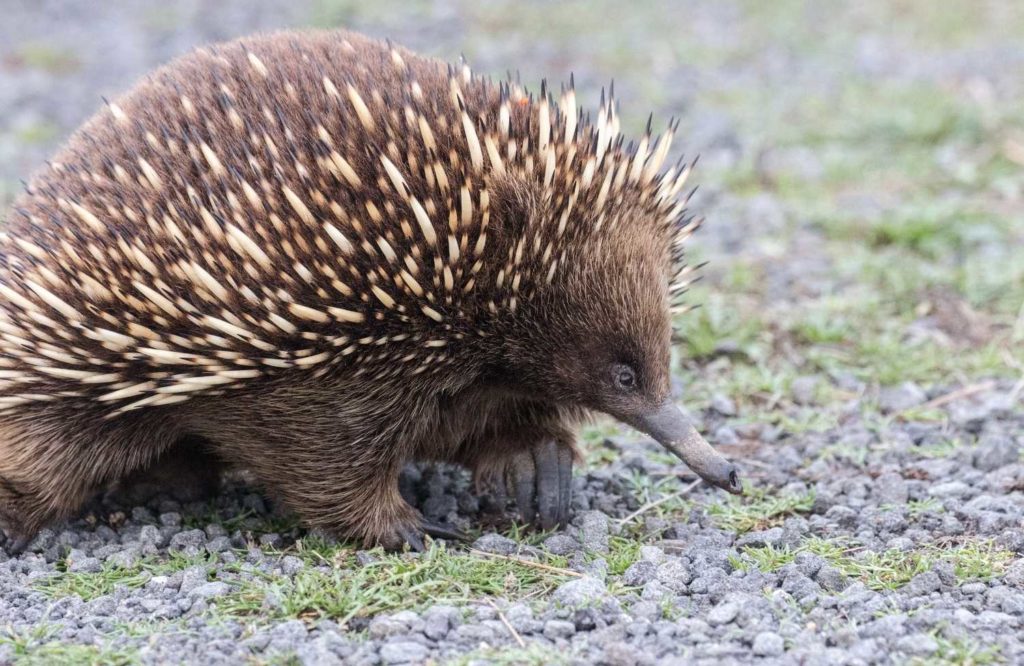
There are five subspecies of the Short Beaked Echidna found in different locations. They are:
- T. a. acanthion, found in Northern and Western Australia
- T. a. aculeatus, found in Queensland, New South Wales, South Australia, and Victoria
- T. a. lawesii, found in New Guinea and Northeast Queensland
- T. a. multiaculeatus, found on Kangaroo Island
- T. a. setosus, found on Tasmania and the Bass Strait islands
Echidna vs. Hedgehog
Both Short Beaked Echidnas and Hedgehogs are very similar-looking mammals. This often causes confusion. But both of them have a lot of structural, visible as well as behavioral differences! In fact, Hedgehogs are actually more closely related to Whales than they are to Echidnas!
There are only four species of Echidnas, with Short Beaked Echidnas being one. On the other hand, there are 17 species of Hedgehogs! Short Beaked Echidnas are native to Australia and New Guinea. Hedgehogs are found in Asia, Africa, Europe, and even New Zealand!
Both Short Beaked Echidnas and Hedgehogs have spines on their body. They can both roll up into balls to defend themselves. However, the number of these spines is higher for Hedgehogs than Echidnas. Also, Echidnas lay eggs, while Hedgehogs give birth to live babies.
Echidnas have an average lifespan of over 10 years. It is only 4 to 7 years for Hedgehogs. Echidnas have long, specialized snouts for feeding on insects like ants and mites. Hedgehogs are omnivorous and feed on insects, snails, roots, fruits, and small mammals!
Are Short Beaked Echidnas in danger?
The Short Beaked Echidna is very common in temperate Australia and New Guinea. So they are not considered endangered and are listed under ‘least concern.’
However, they still face many natural and man-made threats. These have caused them to go extinct in many local areas. Though they can be raised in zoos, it is tough to get captive Echidnas to breed. So it is essential to conserve their populations.
Main Threats to Short Beaked Echidnas
In the wild, adult Short Beaked Echidnas are prey for many predators. Even their spines can’t always protect them! These predators include dingoes, Tasmanian devils, pigs, foxes, and cats and dogs. They are also eaten by snakes, lizards, and even birds. Echidna puggles are the most at risk of becoming prey.
The two most common threats to Short Beaked Echidnas are car accidents and loss of habitat. Over one-third of Echidnas who get killed have been hit by cars. This usually happens when they are crossing busy roads.
Cutting down forests and woodlands also causes their populations to decrease. This is especially true if there is no cut-down wood left in the areas.
Short Beaked Echidnas are hunted and eaten by native Australian people. Due to this, their populations have declined in the New Guinea highlands. They are also prone to infections from parasitic tapeworms and viruses. This happens mainly in areas where they share water supplies.
Interesting Facts about Short Beaked Echidnas
- Short Beaked Echidnas do not have sweat glands and cannot pant!
- Do you know how Short Beaked Echidnas survive wildfires? They burrow themselves and slow down their body’s functions. This makes their temperature drop!
- Short Beaked Echidnas hibernate during winters! Their body temperature drops to 50 degrees Fahrenheit. Their heart rate also slows down to 4 beats per minute.
- They can hibernate while pregnant! Bats are the only other mammals who can do so.
- They use the claws on their back limbs like combs to groom themselves!
- Echidnas and Platypuses are the only mammals to have electroreceptors!
- They have the shortest recorded spinal cords in mammals. This makes them very flexible!
- One of the mascots for the 2000 Summer Olympics in Australia was Millie the Echidna!
Also Read: Guinea Pig Facts
